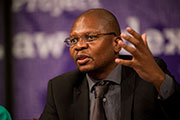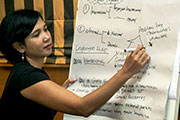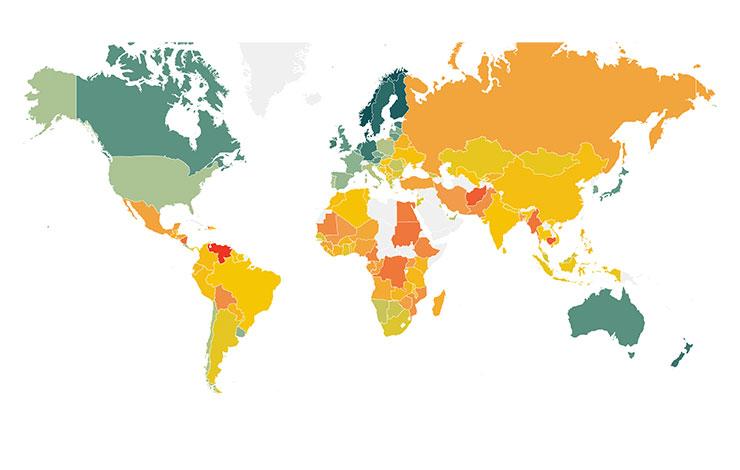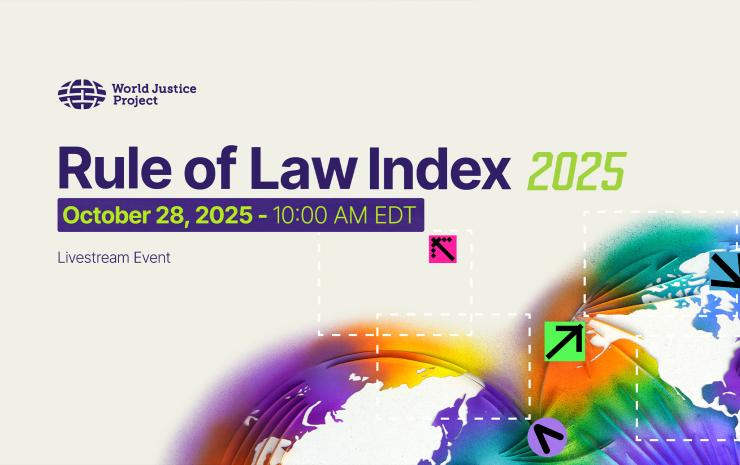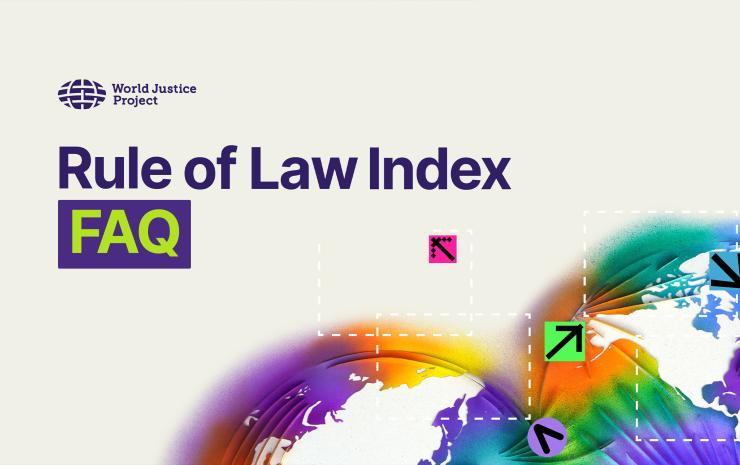
Your essential questions about the World Justice Project Rule of Law Index answered. Understand the methodology, factors, and global policy usage.
About the WJP Rule of Law Index
What is the WJP Rule of Law Index?
The World Justice Project (WJP) Rule of Law Index® is the world’s leading source for independent data on the rule of law, now covering 143 countries and jurisdictions. We gather data from over 215,000 household surveys and 4,100 expert surveys to measure how the rule of law is perceived and experienced globally. The Index is designed to encourage policy reforms, guide program development, and inform research worldwide.
How does WJP define the rule of law?
The World Justice Project defines the rule of law as a durable system of laws, institutions, norms, and community commitment that delivers accountability, just laws, open government, and accessible justice.
These principles are measured in the WJP Rule of Law Index across eight factors:
- Constraints on Government Powers
- Absence of Corruption
- Open Government
- Fundamental Rights
- Order and Security
- Regulatory Enforcement
- Civil Justice
- Criminal Justice
The Conceptual Framework of the Index acknowledges Informal Justice as a ninth factor of the rule of law, however, this concept is not included in the Index’s scores/rankings due to lack of systematic cross-country comparability.
Find out more about our definition at What is the rule of law?
How does the Index account for different definitions of rule of law?
The WJP Rule of Law Index uses a “thick” or substantive approach to the rule of law, meaning it incorporates an extended set of indicators and considers certain rights that are fundamental to rule of law. Instead of only measuring whether the law exists and is applied clearly and equally, the Index includes elements such as fundamental rights protection, absence of corruption, and limits on government power. This approach embeds the rule of law within a broader concept of good governance and justice.
The Index and our surveys have been carefully designed to be applied in countries with vastly different social, cultural, economic, and political systems.
In addition, the Index accounts for different definitions of rule of law and different types of governance by weighting all factors equally. No single factor is given more weight or importance than another.
Who finances the WJP Rule of Law Index?
Our WJP Rule of Law Index is supported by a variety of private donors, international organizations, and government agencies. Crucially, all Index scores are produced in complete independence from donors and any other outside influence, ensuring the integrity and impartiality of our results.
Methodology and Data Sources
What data sources are used to calculate the Index scores?
The Index primarily uses two sources of original data:
- General Population Poll (GPP): Closed-ended experience and perception-based questions administered to a representative sample of 1,000 members of the general public in each country every few years. The poll has historically been conducted in the three largest cities in each country or jurisdiction, but the WJP is transitioning to nationally representative polls. The survey covers topics such as trust in institutions, civic participation, and institutional performance.
- Qualified Respondents’ Questionnaires (QRQs): Closed-ended experience and perception-based questions completed annually by in-country legal practitioners and academics with expertise in one or more of the following four subjects: civil and commercial law; constitutional law, civil liberties, and criminal law; labor law; and public health. The QRQs are administered by the WJP research team on an annual basis in every country or jurisdiction measured in our Index. These questionnaires cover information on the efficacy of courts, the strength of regulatory enforcement, and the reliability of accountability mechanisms.
A small portion (approx. 8%) of the Index’s data comes from third-party sources (e.g., data on civil conflict) to cover topics not captured by our surveys.
Is the data weighted in any way?
Between the GPP, QRQs, and TPS, we collect data on more than 550 question-level variables that are used to build our Index scores. Overall, more of these variables come from the expert surveys, so the expert data makes up a larger percentage of each country’s Index score. The distribution of expert and household survey data varies by factor and depends on the content of each factor. However, neither data source is given greater value than the other. (For example, expert responses are not weighted twice those of households.)
| Data Source | Overall Weight in Index |
|---|---|
| QRQ (Experts) | 65.32% |
| GPP (Public) | 25.83% |
| TPS (Third-Party) | 8.85% |
| F1 QRQ | F1 GPP | F1 TPS | Total | F2 QRQ | F2 GPP | F2 TPS | Total | |
| 66.67% | 31.25% | 2.08% | 100.00% | 64.49% | 35.51% | 0.00% | 100.00% | |
| F3 QRQ | F3 GPP | F3 TPS | Total | F4 QRQ | F4 GPP | F4 TPS | Total | |
| 57.96% | 29.54% | 12.50% | 100.00% | 75.61% | 22.60% | 1.79% | 100.00% | |
| F5 QRQ | F5 GPP | F5 TPS | Total | F6 QRQ | F6 GPP | F6 TPS | Total | |
| 11.11% | 34.44% | 54.44% | 100.00% | 76.00% | 24.00% | 0.00% | 100.00% | |
| F7 QRQ | F7 GPP | F7 TPS | Total | F8 QRQ | F8 GPP | F8 TPS | Total | |
| 93.57% | 6.43% | 0.00% | 100.00% | 77.14% | 22.86% | 0.00% | 100.00% | |
How does WJP keep Rule of Law Index scores up to date?
To ensure that the scores are up-to-date, every year, WJP administers the QRQ surveys (from February to June), and a fraction of the GPP surveys. The third-party source data is updated when new data is released from the respective data producers. The GPP surveys and third-party data serve to anchor the data collected from the Qualified Respondents’ Questionnaires, which are weighted more heavily and collected more often. The combination of these data sources ensures that Index scores are both robust and up to date.
Does WJP validate its Index scores?
WJP cross-checks Index scores against independent quantitative and qualitative sources such as Freedom House’s Freedom in the World report, the Global Competitiveness Index, Transparency International’s Corruption Perceptions Index, V-Dem, the Economic Freedom of the World report, World Economic Forum, Freedom House’s Nation in Transit, Amnesty International country reports, international and national news sources, and many others. The goal of this exercise is to check for consistencies and inconsistencies within WJP’s data and to provide an additional layer of analysis useful in interpreting scores and enhancing in-house files.
To comply with Articles 6b and 6e of ESOMAR’s International Code on Market, Opinion, and Social Research, each individual QRQ participant chooses if they would like to be acknowledged or have their information omitted from all public materials. There are respondents in each country or jurisdiction covered in the Index that do not wish to be acknowledged publicly for a variety of reasons, and the WJP must therefore exclude their names from all reports and documents. The names and affiliations of each QRQ respondent that chose to be acknowledged for their participation in the project can be found in the methodology section of each Index report.
How does WJP identify and vet experts to take the Qualified Respondents Questionnaire?
Potential QRQ participants are identified using various methods, including outreach to universities, bar associations, and NGOs; referrals from previous participants; and online research. Currently, the database contains over 30,000 potential participants. When identifying potential participants, prosecutors, judges, and other government officials are excluded, as the QRQ surveys (available here) aim to capture the perceptions and experiences of practitioners who routinely interact with these systems as agents of the people, as well as scholars who study legal institutions and processes in their countries and jurisdictions.
How many expert surveys are used in each country’s Index score calculations?
On average, there are 29 QRQ respondents per country or jurisdiction. The response rate by country or jurisdiction varies considerably due to factors including overall population size and the total number of potential participants that have been identified.
To comply with Articles 6b and 6e of ESOMAR’s International Code on Market, Opinion, and Social Research, each individual QRQ participant chooses if they would like to be acknowledged or have their information omitted from all public materials. There are respondents in each country or jurisdiction covered in the Index that do not wish to be acknowledged publicly for a variety of reasons, and the WJP must therefore exclude their names from all reports and documents. The names and affiliations of each QRQ respondent that chose to be acknowledged for their participation in the project can be found in the methodology section of each Index report.
How are respondents selected for the General Population Poll?
The GPP household survey is carried out generally once every few years in person or online in the local language(s) in each country or jurisdiction. Our local polling partners develop a sampling plan where respondents are randomly selected to participate in the study. Sampling plans are as representative of certain country-level demographics as possible. The demographics that we take into consideration are gender, age, income or socioeconomic status, city (for samples of the three largest cities), and urban/rural (for nationally representative samples). Sampling plans are based on government census data or other national level statistics in an effort to collect a representative sample of respondents.
What is considered a “statistically significant” change in a factor?
The measure of change over time is constructed in three steps. First, last year’s scores are subtracted from this year’s to obtain, for each country and each factor, the annual difference in scores. To test whether the annual changes are statistically significant, a bootstrapping procedure is used to estimate standard errors. To calculate these errors, 100 samples of respondent-level observations (of equal size to the original sample) are randomly selected with replacement for each country from the pooled set of respondents for last year and this year. These samples are used to produce a set of 100 country-level scores for each factor and each country, which are utilized to calculate the final standard errors. These errors—which measure the uncertainty associated with picking a particular sample of respondents—are then employed to conduct pair-wise t-tests for each country and each factor. Finally, to illustrate the annual change, a measure of change over time is produced based on the value of the annual difference and its statistical significance (at the 10 percent level).
Usage and Limitations
Who uses the WJP Rule of Law Index, and how is it used?
The Index is used by a wide array of stakeholders, including policy makers, civil society organizations, academics, media, and businesses. It is used to:
- Identify strengths and areas for improvement.
- Encourage policy reforms.
- Guide program development.
- Inform risk assessments and investment decisions.
- Stimulate research to strengthen the rule of law.
What are the limitations of the WJP Rule of Law Index?
While the Index is the most comprehensive dataset available, it has three primary limitations:
- Diagnostic Tool Only: It provides data, but it does not dictate concrete priorities or offer a full diagnosis; it must be used with other analytical tools.
- Comparability Challenges: Cultural differences can make cross-country comparisons difficult, and the sensitive nature of some questions can occasionally result in measurement error.
- Survey Frequency and Cost: Due to the high cost, the General Population Poll cannot be conducted as frequently as desired or to a nationally representative sample in all countries (though we are actively transitioning to nationally representative polls).
Why are certain countries and jurisdictions not included?
While the World Justice Project would like to include as many countries and jurisdictions as possible in the WJP Rule of Law Index, we have not been able to expand the Index to include every country or jurisdiction primarily due to resource constraints. As for why specific countries are included and not others, as we have grown our flagship from six countries in 2008 to 143 in the most recent edition, we have chosen jurisdictions to include based on the following considerations:
- Population size: As we first began building the Index, we prioritized the most populous countries and jurisdictions to ensure that it covered as much of the world’s population as possible. We estimate that our Index currently covers 90% of the world’s population.
- Geographic and economic diversity: As we have grown our coverage, we have tried to ensure a balanced representation of different regions and different levels of economic development.
- Feasibility and cost of data collection: We have not been able to include some countries and jurisdictions in our Index due to government restrictions on public opinion polling, high polling costs, safety concerns on the part of our local polling partners, and/or other locally-specific, complicating factors for data collection that would require extra staff time and cost. In addition, those areas that have very few practicing lawyers can pose a challenge to collecting the expert data needed to build our Index scores.
- Funding availability/requirements: Some of the grants that support the WJP Rule of Law Index specifically fund the inclusion of particular geographies and countries/jurisdictions. This source of funding has been the sole determiner of Index expansion in recent years.
Beyond these considerations, the WJP does not have particular policies or priorities that lead us to include or not include a given jurisdiction in our Index.
How do you address sensitive topics people may not want to discuss?
Some of the questions that we ask in our surveys are sensitive in nature. Our local polling partners use a variety of interviewing techniques to ensure that respondents are comfortable answering these questions.
In some cases, a respondent may not be comfortable answering a certain question. Respondents can decline to answer or indicate that they do not know the answer to any question. In very rare cases, it may not be possible to ask a certain question in a given country or jurisdiction. If that is the case, the question may be slightly modified or removed from the questionnaire.
